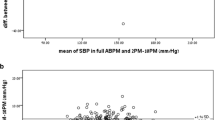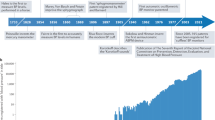Abstract
Blood pressure (BP) is known to vary by time of day and day of year. Studies differ substantially on the magnitude of the effect and there is doubt whether variation is clinically meaningful. We used more than 2 million BP measurements obtained between 1996 and 2004 from Geisinger Clinic primary care patients. General estimating equations were used to determine the effect of time of day and month of year on the probability of identifying BP values above four diagnostic cutoff points (SBP⩾120 mm Hg, SBP⩾140 mm Hg, DBP⩾80 mm Hg, DBP⩾90 mm Hg). Time of day and month of year were significantly associated with the odds of measuring elevated BP, regardless of definition. The odds ratio (OR) for SBP⩾120 mm Hg in the evening (1900 hours) versus midday (1200 hours) was 1.32 (P<0.001). The OR for SBP⩾120 mm Hg in winter to summer months was 1.24 (P<0.001). Similar results were found for each age/gender group. These data indicate that in clinical practice, measurement of an elevated BP may vary by 40% depending on the time of day and month of year. The magnitude of the variability in BP measurement attributable to the combined effect of these temporal factors is clinically significant. Anticipation of changes in BP attributable to temporal factors may improve accuracy of diagnosis and precision of therapy.
This is a preview of subscription content, access via your institution
Access options
Subscribe to this journal
Receive 12 digital issues and online access to articles
$119.00 per year
only $9.92 per issue
Buy this article
- Purchase on Springer Link
- Instant access to full article PDF
Prices may be subject to local taxes which are calculated during checkout


Similar content being viewed by others
References
Hajjar I, Kotchen TA . Trends in prevalence, awareness, treatment, and control of hypertension in the United States 1988–2000. JAMA 2003; 290: 199–206.
Mann S, Bellamy GR, Hunyor SN, Raftery EB, Ingall T, Bannister R . Supine hypertension, blood pressure variability and circadian rhythm in autonomic failure: the role of ambulatory intra-arterial monitoring. Clin Exp Pharmacol Phys 1984; 11: 347–350.
Verdecchia P, Schillaci G, Porcellati C . Dippers versus non-dippers. J Hypertens 1991; 9: S42–S44.
O'Brien E, O'Malley K . Clinical blood pressure measurement. In: Robertson JIS (ed). Clinical Hypertension. Elsevier: Beerse, Belgium, 1992, pp 14–50.
Coca A . Circadian rhythm and blood pressure control: physiological and pathophysiological factors. J Hypertens 1994; 12: S13–S21.
Pickering TG, Pieper C, Schechter CB . Ambulatory Monitoring and Blood Pressure Variability. Science Press: London, 1991.
Staessen JA, Fagard RH, Lijnen PJ, Thijs L, Van Hoof R, Amery AK . Mean and range of the ambulatory pressure in normotensive subjects from a meta-analysis of 23 studies. Am J Cardiol 1991; 67: 723–727.
Minami J, Kawano Y, Ishinimitsu T, Yoshimi H, Takishita S . Seasonal variations in office, home, and 24 h ambulatory blood pressure in patients with essential hypertension. J Hypertens 1996; 14: 1421–1425.
Woodhouse PR, Khaw KT, Plummer M . Seasonal variation of blood pressure and its relationship to ambient temperature in an elderly population. J Hypertens 1993; 11: 1267–1274.
Nietert PJ, Wessell AM, Feifer C, Ornstein SM . Effect of terminal digit preference on blood pressure measurement and treatment in primary care. Am J Hypertens 2006; 19: 147–152.
Wingfield D, Cooke J, Thijs L, Staessen JA, Fletcher AE, Fagard R et al. Terminal digit preference and single-number preference in the Syst-Eur trial: influence of quality control. Blood Press Monit 2002; 7: 169–177.
Author information
Authors and Affiliations
Corresponding author
Rights and permissions
About this article
Cite this article
Thomas, C., Wood, G., Langer, R. et al. Elevated blood pressure in primary care varies in relation to circadian and seasonal changes. J Hum Hypertens 22, 755–760 (2008). https://doi.org/10.1038/jhh.2008.44
Received:
Revised:
Accepted:
Published:
Issue Date:
DOI: https://doi.org/10.1038/jhh.2008.44
Keywords
This article is cited by
-
Seasonal blood pressure variation: implications for cardiovascular risk stratification
Hypertension Research (2018)
-
Seasonal variation in self-measured home blood pressure among patients on antihypertensive medications: HOMED-BP study
Hypertension Research (2017)
-
Seasonal and monthly variation in occurrence of hypertensive urgency
Internal and Emergency Medicine (2013)



